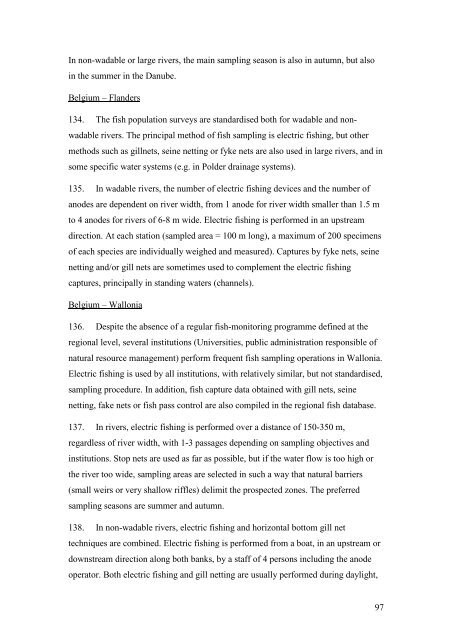Report on Harmonisation of freshwater biological methods
Report on Harmonisation of freshwater biological methods
Report on Harmonisation of freshwater biological methods
You also want an ePaper? Increase the reach of your titles
YUMPU automatically turns print PDFs into web optimized ePapers that Google loves.
In n<strong>on</strong>-wadable or large rivers, the main sampling seas<strong>on</strong> is also in autumn, but alsoin the summer in the Danube.Belgium – Flanders134. The fish populati<strong>on</strong> surveys are standardised both for wadable and n<strong>on</strong>wadablerivers. The principal method <strong>of</strong> fish sampling is electric fishing, but other<strong>methods</strong> such as gillnets, seine netting or fyke nets are also used in large rivers, and insome specific water systems (e.g. in Polder drainage systems).135. In wadable rivers, the number <strong>of</strong> electric fishing devices and the number <strong>of</strong>anodes are dependent <strong>on</strong> river width, from 1 anode for river width smaller than 1.5 mto 4 anodes for rivers <strong>of</strong> 6-8 m wide. Electric fishing is performed in an upstreamdirecti<strong>on</strong>. At each stati<strong>on</strong> (sampled area = 100 m l<strong>on</strong>g), a maximum <strong>of</strong> 200 specimens<strong>of</strong> each species are individually weighed and measured). Captures by fyke nets, seinenetting and/or gill nets are sometimes used to complement the electric fishingcaptures, principally in standing waters (channels).Belgium – Wall<strong>on</strong>ia136. Despite the absence <strong>of</strong> a regular fish-m<strong>on</strong>itoring programme defined at theregi<strong>on</strong>al level, several instituti<strong>on</strong>s (Universities, public administrati<strong>on</strong> resp<strong>on</strong>sible <strong>of</strong>natural resource management) perform frequent fish sampling operati<strong>on</strong>s in Wall<strong>on</strong>ia.Electric fishing is used by all instituti<strong>on</strong>s, with relatively similar, but not standardised,sampling procedure. In additi<strong>on</strong>, fish capture data obtained with gill nets, seinenetting, fake nets or fish pass c<strong>on</strong>trol are also compiled in the regi<strong>on</strong>al fish database.137. In rivers, electric fishing is performed over a distance <strong>of</strong> 150-350 m,regardless <strong>of</strong> river width, with 1-3 passages depending <strong>on</strong> sampling objectives andinstituti<strong>on</strong>s. Stop nets are used as far as possible, but if the water flow is too high orthe river too wide, sampling areas are selected in such a way that natural barriers(small weirs or very shallow riffles) delimit the prospected z<strong>on</strong>es. The preferredsampling seas<strong>on</strong>s are summer and autumn.138. In n<strong>on</strong>-wadable rivers, electric fishing and horiz<strong>on</strong>tal bottom gill nettechniques are combined. Electric fishing is performed from a boat, in an upstream ordownstream directi<strong>on</strong> al<strong>on</strong>g both banks, by a staff <strong>of</strong> 4 pers<strong>on</strong>s including the anodeoperator. Both electric fishing and gill netting are usually performed during daylight,97














![Accommodation booking form [PDF]](https://img.yumpu.com/39471785/1/184x260/accommodation-booking-form-pdf.jpg?quality=85)

